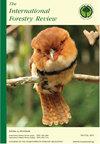Learning from Community-Based Natural Resource Management (CBNRM) in Ghana and Zambia: Lessons for Integrated Landscape Approaches
IF 0.9
4区 农林科学
Q2 FORESTRY
引用次数: 8
Abstract
HIGHLIGHTS Inclusive, equitable multi-actor collaboration and sustainability are key to CBNRM. In practice, donors, government agencies, NGOs and community elites often control decision-making. Ongoing collaboration across actors and scales requires long-term support and engagement. Integrated Landscape Approaches (ILAs) are promising for improved natural resource management. Learning from CBNRM and documenting ILA processes is needed for adaptive management. SUMMARY Land use in much of sub-Saharan Africa is dominated by legislative frameworks based on a strong colonial legacy, focusing strongly on state control and minimal devolution of management responsibilities to local communities. However, attempts to reconcile conservation and socio-economic development by increasing stakeholder engagement in community-based natural resource management (CBNRM) have been undertaken since the late 1980s. Based on a review of published literature on historical land-use trajectories, the evolution of CBNRM, and key respondent interviews with NRM experts in Ghana and Zambia, this paper asks: What lessons can be learned from CBNRM to inform integrated landscape approaches for more equitable social and ecological outcomes? The paper discusses the positive characteristics and persistent challenges arising from CBNRM initiatives in both countries. The former being, improved rights and resource access, an established institutional structure at the local level, and a conservation approach tailored to the local context. The latter include the absence of multi-scale collaboration, inadequate inclusive and equitable local participation, and limited sustainability of CBNRM initiatives beyond short-term project funding timelines. The paper argues that integrated landscape approaches can address these challenges and improve natural resource management in Ghana and Zambia. We urge landscape practitioners to consider how the lessons learned from CBNRM are being addressed in practice, as they represent both challenges and opportunities for landscape approaches to improve natural resource management.从加纳和赞比亚社区自然资源管理(CBNRM)中学习:综合景观方法的经验教训
包容、公平的多方合作和可持续性是CBNRM的关键。在实践中,捐助者、政府机构、非政府组织和社区精英往往控制着决策。跨参与者和规模的持续合作需要长期的支持和参与。综合景观方法(ILAs)有望改善自然资源管理。适应性管理需要学习CBNRM并记录ILA过程。撒哈拉以南非洲大部分地区的土地使用都是由基于强烈殖民遗产的立法框架主导的,这些立法框架强烈强调国家控制,将管理责任下放给当地社区的程度降到最低。然而,自20世纪80年代末以来,一直试图通过增加利益相关者参与社区自然资源管理(CBNRM)来协调保护和社会经济发展。基于对历史土地利用轨迹、CBNRM演变的已发表文献的回顾,以及对加纳和赞比亚NRM专家的主要受访者访谈,本文提出了以下问题:从CBNRM中可以吸取哪些教训,为综合景观方法提供信息,以实现更公平的社会和生态结果?本文讨论了两国CBNRM倡议的积极特征和持续挑战。前者是改善权利和资源获取,建立地方一级的体制结构,以及适合当地情况的保护办法。后者包括缺乏多规模的合作,缺乏包容性和公平的地方参与,以及CBNRM计划在短期项目资助时间表之外的可持续性有限。该论文认为,综合景观方法可以解决这些挑战,并改善加纳和赞比亚的自然资源管理。我们敦促景观从业者考虑如何在实践中处理从CBNRM中吸取的经验教训,因为它们代表了景观方法改善自然资源管理的挑战和机遇。
本文章由计算机程序翻译,如有差异,请以英文原文为准。
求助全文
约1分钟内获得全文
求助全文
来源期刊

International Forestry Review
农林科学-林学
CiteScore
2.50
自引率
6.20%
发文量
29
审稿时长
>36 weeks
期刊介绍:
The International Forestry Review is a peer-reviewed scholarly journal that publishes original research and review papers on forest policy and science, with an emphasis on issues of transnational significance. It is published four times per year, in March, June, September and December. Special Issues are a regular feature and attract a wide audience. Click here for subscription details.
 求助内容:
求助内容: 应助结果提醒方式:
应助结果提醒方式:


